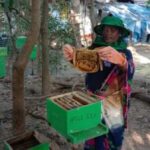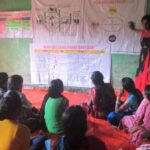Priya Munda is a 22-year-old girl from Lohanda Mundasari, a village in the Kheonjhar district of Odisha. Her village does not have direct road connectivity. One has to cross a railway track, and walk 1.5 km to reach the village.
On the way to her village is a pond. Munda’s day includes fetching water and helping her mother in the livelihood activities of a self-help group of which she is a member.
For her sanitation needs, she goes to the pond, usually accompanied by her younger cousin. She bathes hurriedly in the pond, partially clothed. She feels awkward to bathe near the well, where the other women of her village bathe. She disposes of her menstrual pad by digging a hole near the pond and burying it.
Lack of options
Munda admits that she does not feel clean after bathing in the pond, but has no other option. Households in Lohanda Mundasari are among the 55% rural households in India and among the 95.31% of rural households of Odisha that do not have enclosed bathing spaces, as per Census 2011.
The intent of bathing, which is cleanliness of the body, is lost, along with convenience and comfort, when women bathe in the open. The reason for this behavior can be attributed to the availability and design of water supply and sanitation infrastructure, that are highly inadequate in rural India. Women welcome change now, as they understand the importance of hygiene.
Women’s participation
Women in Munda’s village laughed when asked about their bathing practices, indicating the lack of awareness about hygienic bathing practices. Having understood the importance of privacy and hygiene that enclosed bathing spaces bring, Lohanda Mundasari village is ready to get sanitation facilities and piped water supply.

Gram Vikas, a non-governmental organization that is bringing the sanitation facilities to Lohanda Mundasari, ensures inclusivity, sharing of costs, and the participation of women. The participation of women ensures that they can voice their needs and concerns more freely.
The intervention ensures that every household in the village constructs for itself, a toilet and bathroom, with 24-hour piped water supply in the toilet and bathroom, as well as in the kitchen.
A committee that has men and women members oversees the collection and use of funds, monitoring the construction and maintenance of the sanitation structures. The participation of women ensures that they are part of the decision-making process, resulting in an effective intervention.
Community’s contribution
Water supply to the bathrooms and toilets is from an overhead water tank. The water is pumped up using electric pumps or the gravity flow system. Sewage from toilets flow into soak pits; the grey water from bathrooms flows into the drainage systems or kitchen garden if space permits.
National Rural Drinking Water Program (NRDWP), a scheme of the Ministry of Drinking Water and Sanitation, contributes about 90%, for piped water supply. Villagers contribute a minimum of 50% of the cost of toilets and bathrooms, and up to 10% of the cost of establishing a water supply system.
Gram Vikas provides technical assistance to construct them, in addition to facilitating households to access Rs. 12,000 under Swachh Bharat Abhiyan. People manage the rest by using local materials, physical labor and cash contribution. People’s contribution creates a sense of ownership for the assets, thus ensuring usage and maintenance.

Benefits of bathing space
Every household in Kanamana village has piped water supply since 2006. A group of women were processing cashew in their house. They said that water supply and sanitation facilities has helped them have time for other activities and that is how they started the cashew processing unit at home.
They used to bathe and get water from a pond before the intervention. They said that incidences of skin diseases, cold and cough were high then.
During menstruation, it has become comfortable for the women to clean themselves properly. They have started using sanitary pads now, as it is more convenient to change in the enclosed bathing space. Their health has improved because of the sanitation facilities and water supply.
Bathing spaces and water availability
Earlier studies found that water availability played an essential role in the usage of bathing spaces. The interaction with villagers during this study confirmed the same and showed that water availability is an important issue to be addressed.
People are willing to build bathrooms if they are assured of water supply. Without water, a bathroom would remain a concrete structure that may later be used for storage or some other purpose.
Bathing loses its intrinsic value if one bathes in ponds, near pumps or wells. It also loses its value when people use the bathroom only if there is water supply. An enclosed bathing space can be one of the social advantages a connected water supply can bring.
However, it is necessary for a woman to understand the need for enclosed and hygienic bathing spaces and its benefits to her health, livelihood and dignity.
Vaishnavi Pawar is a researcher at VikasAnvesh Foundation in Pune. Views are personal.








